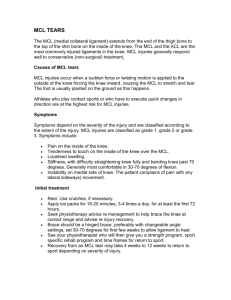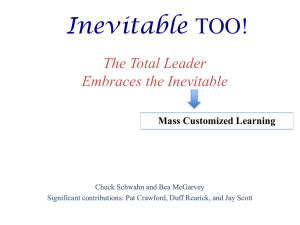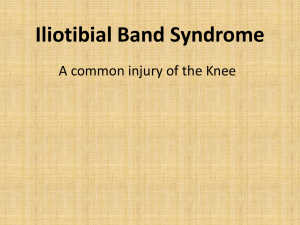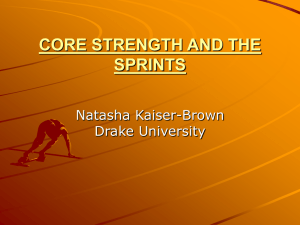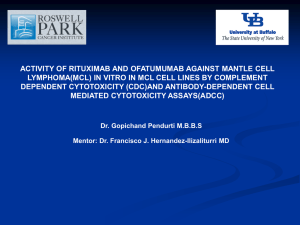Medial collateral ligament injuries1
advertisement
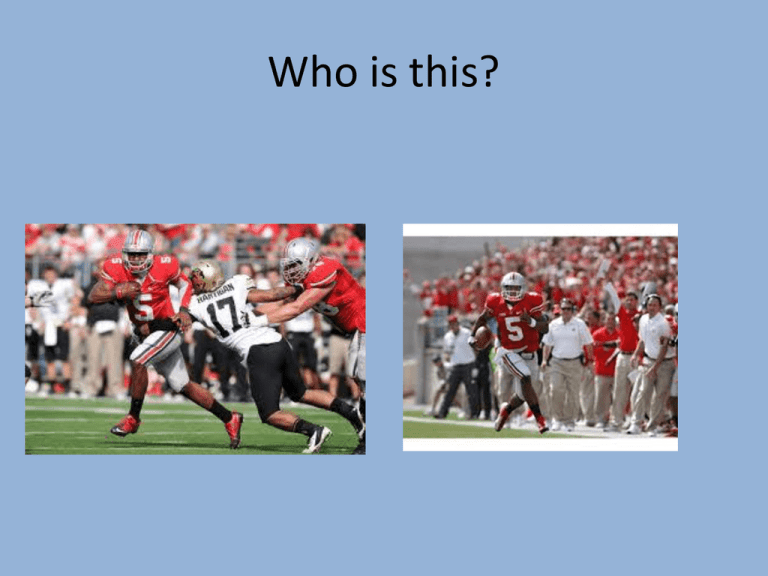
Who is this? What Happened? How much rain? Medial Collateral Ligament MCL • The medial collateral ligament (MCL) is one of four ligaments that are critical to the stability of the knee joint. • A ligament is made of tough fibrous material and functions to control excessive motion by limiting joint mobility. • The MCL resists widening of the inside of the joint, or prevents "opening-up" of the knee. One of the most common knee ligaments injuries in sports Anatomy -Three layers • Superficial MCL – primary static stabilizer (under the satorial fascia) – valgus and ER • Deep MCL – middle third of medial capsule • Posterior Oblique Ligament – 3 attachments functions with semimembranosus Dynamic stabilizers of medial knee • Semimembranous complex • Quadriceps • Pes anserine MCL Injuries • Because the MCL resists widening of the inside of the knee joint, the ligament is usually injured when the outside of the knee joint is struck. • This force causes the outside of the knee to buckle, and the inside to widen. • When the MCL is stretched too far, it is susceptible to tearing and injury. • An injury to the MCL may occur as an isolated injury, or it may be part of a complex injury to the knee. • Other ligaments, most commonly the ACL, or the meniscus, may be torn along with a MCL injury. Symptoms of MCL Tears • The most common symptom following an MCL injury is pain directly over the ligament. • Swelling over the torn ligament may appear, and bruising and generalized joint swelling are common 1 to 2 days after the injury. • In more severe injuries, patients may complain that the knee feels unstable, or feel as though their knee may 'give out' or buckle. • Symptoms of a MCL injury tend to correlate with the extent of the injury. MCL injuries are usually graded on a scale of I to III. Symptoms • 67% of patients with complete tear could walk into the office unaided • Pain was worse with incomplete rather than complete X-rays • Anteroposterior • Lateral • Merchant view Grade I MCL Tear • This is an incomplete tear of the MCL. • The tendon is still in continuity, and the symptoms are usually minimal. • Patients usually complain of pain with pressure on the MCL, and may be able to return to their sport very quickly. • Most athletes miss 1-2 weeks of play. Grade II MCL Tear • considered incomplete tears of the MCL. • These patients may complain of instability when attempting to cut or pivot. • The pain and swelling is more significant, and usually a period of 3-4 weeks of rest is necessary. Grade III MCL Tear • A grade III injury is a complete tear of the MCL. • Patients have significant pain and swelling, and often have difficulty bending the knee. • Instability, or giving out, is a common finding with grade III MCL tears. • A knee brace or a knee immobilizer is usually needed for comfort, and healing may take 6 weeks or longer. MCL injuries • Isolated • Combined with other injuries Knee in 30 degrees of flexion compare to other knee – degree of opening and the end feel Surgery for MCL Tears: • Surgery for MCL tears is controversial. • There are many studies that document successful nonsurgical treatment in nearly all types of MCL injuries. • patients who complain of persistent knee instability,, surgery is reasonable. • Some surgeons advocate surgical treatment of grade III MCL tears in elite athletes or in those athletes with multiple ligament injuries in the knee Rehabilitation • Early protected ROM • Strengthening • Laxity of knee in extension – red flag Treatment • Treatment of an MCL tear depends on the severity of the injury. • Treatment always begins with allowing the pain to subside, beginning work on mobility, followed by strengthening the knee to return to sports and activities. • Bracing can often be useful for treatment of MCL injuries. • Fortunately, surgery is not necessary for the majority Rehabilitation Protocol • MCL injuries who require an early return to high level activity following injury. • Goals of rehabilitation are to: Control joint pain, swelling Regain normal knee range of motion Regain a normal gait pattern Regain normal lower extremity strength Regain normal proprioception, balance, and coordination • The physical therapy is to begin as soon as possible after the injury. Phase 1: Week 1-2 Range of Motion: • Passive ROM, No limits • Aggressive Patella mobility • Ankle pumps • Gastroc-soleus stretches • Wall slides • Heel slides Strength: • Quad sets x 10 minutes • SLR (flex, abd, add) • Multi-hip machine (flex, abd, add) • Mini squats (0-45 °) • Multi-angle isometrics (90-60 °) (No tension on MCL) • When working adductors stress point should be superior to knee • Calf Raises Balance Training: Weight shifts (side/side, fwd/bkwd) Single leg balance Plyotoss Weight Bearing: Wt bearing as tolerated Crutches until quad control is gained, then discontinued Bicycle: May begin when 110 ° flex is reached Modalities: E-stim/biofeedback as needed Ice 15-20 minutes with knee at 0 ° ext Brace: Wear brace at all times with the following exceptions: Remove brace to perform ROM and PT activities Immobilizer is D/C'd at 2 weeks pending physician exam Goals for Phase 1: ROM Phase 2: Week 3 Range of Motion: Passive ROM, No limits Aggressive Patella mobility Strength: • Continue remedial strengthening as needed • Leg press • Step up, step down • Stairmaster • Leg curl • Multi-hip machine (flex, abd, add) • When working adductors stress point should be superior to knee • Calf Raises Weight Bearing: Full weight bearing Bicycle: Increase tension Balance Training: • Balance board/2 legged • Cup walking/hesitation walk • Single leg balance • Plyotoss Modalities: E-stim/biofeedback as needed Ice 15-20 minutes with knee at 0 ° ext Goals for Phase 2: ROM 0-125 ° Increase muscle strength and endurance Restore proprioception Brace: Wear brace at all times with the following exceptions: Remove brace to perform ROM and PT activities immobilizer is D/C'd at 2 weeks pending physician exam Phase 3: Week 4 Range of Motion: Passive ROM, No limits Aggressive Patella mobility Strength: • Progressive resistance exercises • Smith press • Leg press • Step up, step down • Stairmaster • Leg curl • Multi-hip machine (flex, abd, add) • When working adductors stress point should be superior to knee • Calf Raises Weight Bearing: Begin jogging Progress functional agility exercises as tolerated Bicycle: Increase tension Balance Training: • Balance board/2 legged • Cup walking/hesitation walk • Single leg balance • Plyotoss Modalities: E-stim/biofeedback as needed Ice 15-20 minutes with knee at 0 ° ext Brace: None Goals for Phase 3: • ROM Full • Increase muscle strength and endurance • Jogging • Functional Agility Exercises Phase 4: Week 5-6 Range of Motion: Passive ROM, No limits Aggressive Patella mobility Strength: • Progressive resistance exercises • Smith press • Leg press • Step up, step down • Stairmaster • Leg curl • Multi-hip machine (flex, abd, add) Weight Bearing: Functional agility exercises as tolerated Progress to sprinting Progress to sports specific agility drills Bicycle: • As needed Balance Training: Steam boats in 4 planes Single leg stance with plyotoss Wobble board balance work-single leg ½ Foam roller work Modalities: E-stim/biofeedback as needed Ice 15-20 minutes with knee at 0 ° ext Goals for Phase 4: ROM Full Increase muscle strength and endurance Sprinting Sport Specific Agility Exercises Return to sport • is allowed when the patient can perform sprinting and sports specific agility drills in an unrestricted manner. • This usually occurs at the 5-6 week post-injury date
